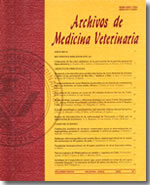Rectal stricture of postmortem examined pigs in a farrow-to-finishing unit. Considerations about the prevalence, pathology, etiology and pathogenesis
Main Article Content
Abstract
The aim of this work was to study the prevalence, the pathological findings as well as the etiology of rectal stricture in a farrow-to-finishing farm during two periods, 1996 and 1998-99. In the first period, over 660 necropsied pigs belonged to nursery, grower and fattener categories, monthly median percent was 7.5% with values higher than 10% in the summer months for all categories and in September and December for nursery and grower pigs, respectively. In the second period, 879 pigs were examined and rectal stricture accounted for 10.3% and rectal prolapse for 7.7% with an average age of 164.2±6.1 y 115.8±4.2 days, respectively. Affected pigs showed abdominal distension and poor growth. Gross findings were distended rectum, spiral colon and cecum usually with fibrinous peritonitis and pericarditis. The rectal stricture was found about 2.5 to 5 cm in craneal to the anus with 3 to 8 cm in lengh. Bacteriological studies carried out from selected samples were negative for a common swine gut pathogens. One hundred twenty two samples for aflatoxins and zearalenone and 36 for deoxynivalenol investigation of commodities by a competition ELISA test were performed. There was not a direct correlation between high incidence of rectal stricture and levels of zearalenone, even though on field situation, little is known about what happens when this mycotoxin is fed in low levels along the year, alone or in association with deoxynivalenol. It was concluded that rectal stricture is a condition that affects pig production. Their etiology appears multifactorial and mycotoxins, particularly zearalenone, seem to play an important role as a primary cause of rectal prolapse followed by rectal stricture as a sequel to untreated cases.

